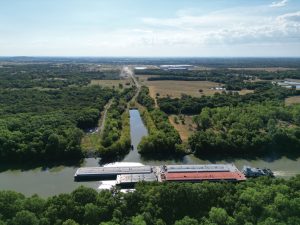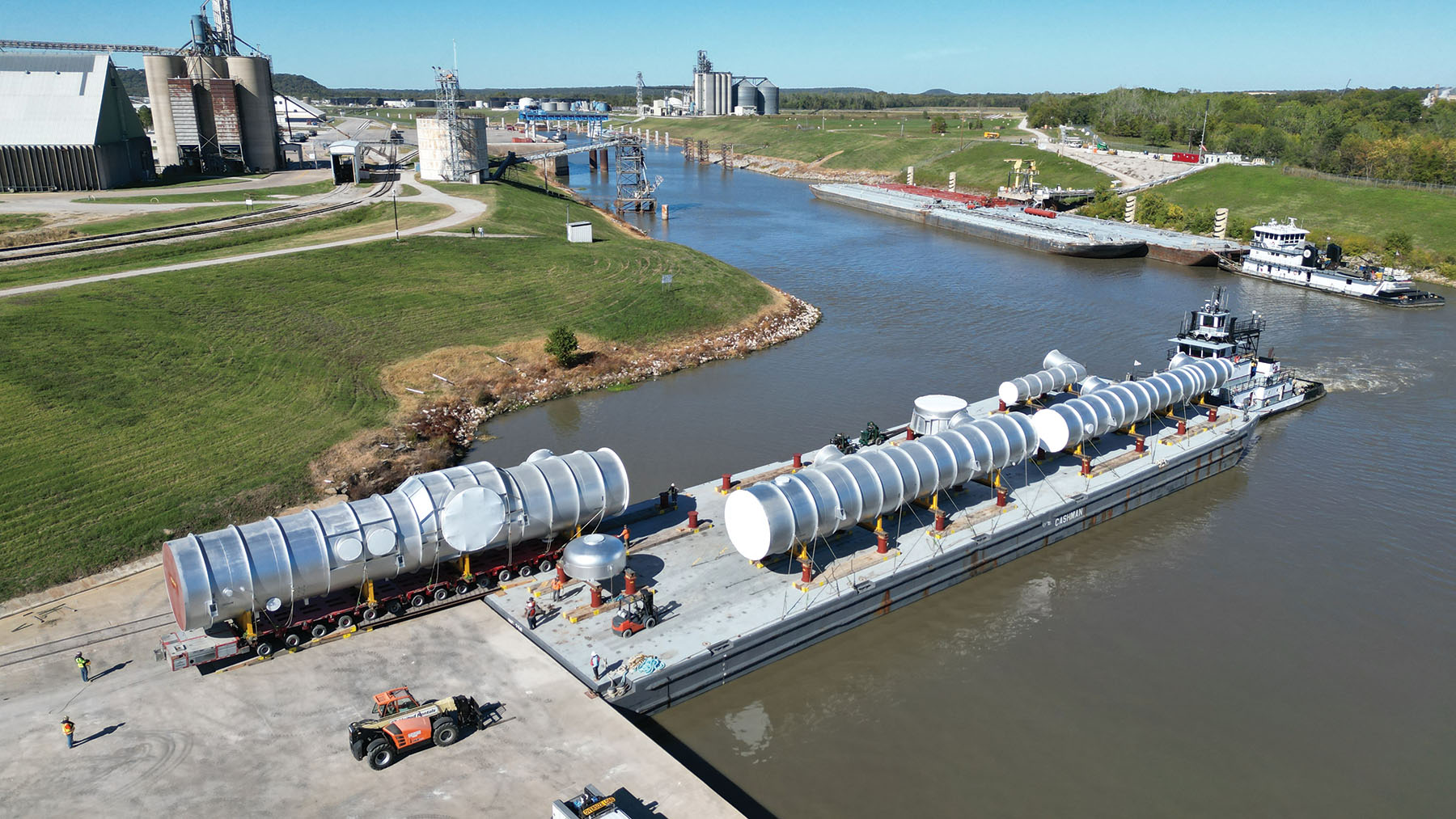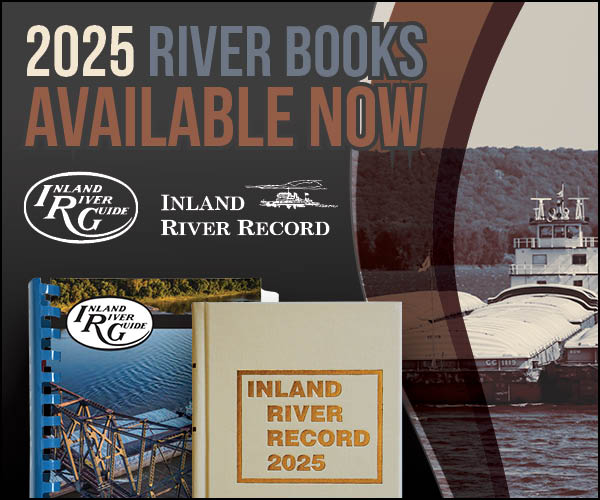In 2019, Tulsa Ports added 2,000 acres to its footprint with a new site, the Port of Inola. “We have put a lot of infrastructure into place since then,” said Sheila Shook, director of workforce and education at Tulsa Ports. That infrastructure investment includes a new $20 million rail spur that opened just last year and that connects the port to the Union Pacific rail system.
Tulsa Ports includes the ports of Catoosa and Inola near Tulsa, Okla., on the Verdigris River, a tributary of the Arkansas and Mississippi rivers. The ports are at and near the head of navigation for the McClellan-Kerr Arkansas River Navigation System. Tulsa Port of Catoosa serves as the region’s primary facility for bulk cargo shipments. The port benefits from its direct connection to the MKARNS, a 445-mile waterway system that links it to the Mississippi River, providing a cost-effective route for bulk goods moving between the central United States and international markets.
In addition to its waterway access, the Port of Catoosa has robust rail connections to major Class I and short-line railroads, including BNSF Railway and SKOL (South Kansas Oklahoma Line) Railroad. This multimodal infrastructure allows goods to be efficiently transferred between barges, railcars and trucks, streamlining the supply chain for a variety of industries.

Currently, the Port of Catoosa handles more than 2 million tons of cargo annually, with agricultural products like soybeans, wheat and fertilizers comprising the majority of shipments as well as steel, chemicals and other materials critical to manufacturing and construction. Many businesses in the region have said that the continued success of their operations would not be possible without the accessibility of the waterway system that Tulsa Ports provides.
The Tulsa Port of Inola, a recent addition to Tulsa Ports’ network, has further expanded the organization’s capabilities. Opened in 2019, this facility lies 13 river miles downstream on the Verdigris River from the Tulsa Port of Catoosa and is designed to support significant manufacturing development. It is also positioned to enhance the region’s logistics capabilities, thanks to its direct connection to the Union Pacific Railroad, through the Verdigris Southern Railroad, a 4.4-mile rail spur completed by the port authority in 2024. This rail line provides critical transportation options for port tenants, such as the Italian-based paper manufacturer Sofidel, which completed its 1.8 million square foot manufacturing facility at the port in 2020.
Recent Infrastructure Projects and Growth
Tulsa Ports has made significant investments in infrastructure to accommodate growing demand and ensure future competitiveness. The Tulsa Port of Inola now handles as much cargo as the Port of Paducah, Ky., according to Shook.The Verdigris Southern Railroad was completed on March 29, 2024, with the first delivery into the port taking place April 10, but it was formally inaugurated in June. The shipment included seven rail cars of raw materials delivered to Sofidel. The rail cars originated near Kamloops, British Columbia, Canada.
“The Verdigris Southern Railroad represents a significant advancement in our multi-modal shipping capabilities at the Port of Inola,” said David Yarbrough, executive director of Tulsa Ports, at the time. The new track provides more transportation options for Sofidel America and future tenants interested in locating to the Tulsa Port of Inola, Shook said.
Wastewater Plant
The other big infrastructure project at the Port of Inola is a new $14 million wastewater treatment plant under construction. Out of hundreds of millions of dollars the Oklahoma Water Resources Board received in pandemic relief funds in 2023, it dedicated $14 million to the Port of Inola and the City of Inola’s wastewater needs. The project is due to be completed by October 2026.
The OWRB Tribal Matching Fund, Muscogee Creek Nation, Rogers County and other sources provided additional funding. The plan uses $10 million of the $14 million to improve Inola’s existing wastewater infrastructure. The remaining $4 million will assist with environmental clearance and connections of the town to the new plant within the industrial park. The town’s residents need the water treatment as much as the port itself. About 3,300 employees of the port’s 50 companies live in Catoosa, and another 5,000 to 8,000 in Inola.
The wastewater infrastructure project recently received high praise from Oklahoma’s Office of Management and Enterprise Services (OMES) as well as legislators. “I’m thankful for the investment being made in the Port of Inola project,” said state Sen. Julie McIntosh after a recent visit by elected officials. “This will be instrumental in modernizing our infrastructure and fueling economic growth in the Tulsa metro area. With monies allocated to develop a state-of-the-art wastewater treatment facility and implement critical system upgrades, this investment is set to drive expansion and create new job opportunities.”
“Adding the rail spur and the wastewater treatment plant keeps us in the running” as companies look for desirable locations, Shook said. “We’re getting a lot of interest.”
Currently about 90 percent of the port’s cargoes are agricultural, from corn and soybeans to molasses and fertilizer. The rest include coiled steel. “We move a lot of steel, up to 60 rolls at a time,” Shook said.
In addition to bulk commodities, Tulsa Ports is also a key player in moving project cargo, such as heavy equipment, thanks to its specialized roll-on/roll-off (Ro/Ro) facility, which is capable of handling oversized cargo directly from deck barges. This facility is a unique asset that differentiates Tulsa Ports’ cargo-handling capabilities from its companion ports on the navigation system.
The port is looking to the future, especially with regard to container-on-vessel traffic, or container-on-barge, as it is sometimes called. “We’re not moving COB now, but we’ve been thinking about it for years. We need to have a plan for empty containers,” Shook said. By offering intermodal service, Tulsa Ports would be able to support an even more diverse cargo mix and expand its role in global trade.
“We ship and receive internationally,” Shook concluded. “Most of our soybeans go overseas. We get dry fertilizer from eight countries. If it wasn’t for the waterways, we would not be here.”
————
Featured photo caption: Cargo is unloaded from a deck barge at the Tulsa Port of Catoosa. (Photos courtesy of Tulsa Ports)




